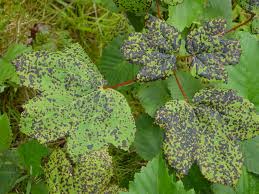
c/o: en.wikipedia.orgNothing is more exciting than watching the snow melt away, the green grass grow in and the flowers start to bud on the trees. These are true signs that spring is here for good and the winter weather is behind us. Yet as New Jersey gets hit with heavy rains, foliar diseases in the landscape are more likely to occur. The most common diseases show up as spots, blisters and blotches on trees and shrubs, but they are generally not damaging to the plant itself. Still, these diseases can be an eyesore to a budding garden.
Foliar diseases show up in the spring because of the mix of rains and cooler temperatures. The most common types of diseases that are seen at this time of the year include:
- Leaf spots
- Anthracnose
- Scab and rust
- Sphaeropsis shoot blight and canker
- Tip blight
- Oak leaf blister
- Horse chestnut leaf blotch
- Volutella blight
- Ash rust
- Rhabdocline
- Swiss needle casts
Fortunately, there are things you can do to reduce the chances that your trees and shrubs will come into contact with a foliar disease. The first step is to reduce the wetness and humidity surrounding the plants. To do this, improve the air flow by neatly spacing out shrubs, managing weeds and avoiding overwatering. Also, irrigate in the early morning hours. Second, if disease does pop up, remove the sources of the disease immediately. Rake up wet leaves on the ground, prune away affected tissues and remove plants that are severely sick.
Finally, the best thing you can do to prevent foliar diseases is to keep your plants and trees healthy. When the shrubs are healthy, they are less likely to be taken over by a disease, and if they are, the nature of the disease is much less severe. Keep in mind that foliar diseases prefer wet, cooler temperatures, so if the area receives a lot of rain in the spring months, you can expect to see more of these diseases. If this is the case, you may want to consider a fungicide to use as management.
